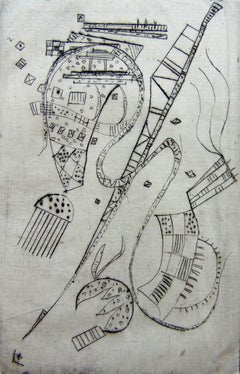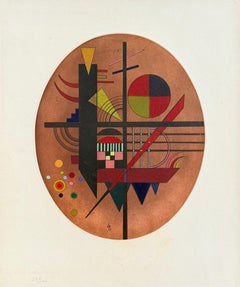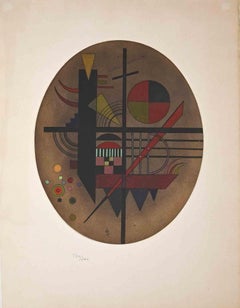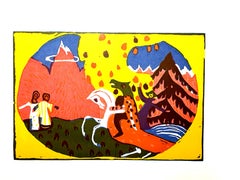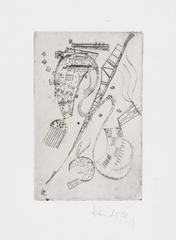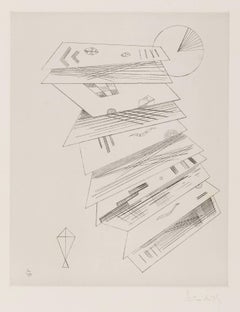Kandinsky And Etching
1930s Surrealist Figurative Prints
Etching
1930s Abstract Geometric Abstract Prints
Drypoint, Etching
1910s Abstract Abstract Prints
Drypoint
1960s Abstract Abstract Prints
Etching
1950s Symbolist More Prints
Watercolor, Etching
1960s Abstract Abstract Prints
Etching, Aquatint
1960s Abstract Geometric Animal Prints
Etching
1930s Abstract Abstract Prints
Etching
1930s Modern Abstract Prints
Etching
1930s Abstract Expressionist Prints and Multiples
Etching
1930s Abstract Abstract Prints
Drypoint, Etching
1930s Abstract Geometric Abstract Prints
Etching
1930s Abstract Prints and Multiples
Etching
1920s Abstract Prints
Drypoint
1930s Abstract Geometric Abstract Prints
Etching
1960s Abstract Geometric Animal Prints
Etching
1960s Abstract Abstract Prints
Etching
1960s Abstract Abstract Prints
Etching
1930s Modern Abstract Prints
Drypoint, Etching
20th Century Bauhaus Abstract Prints
Drypoint, Etching
Kandinsky And Etching For Sale on 1stDibs
How Much is a Kandinsky And Etching?
Finding the Right Prints-works-on-paper for You
Decorating with fine art prints — whether they’re figurative prints, abstract prints or another variety — has always been a practical way of bringing a space to life as well as bringing works by an artist you love into your home.
Pursued in the 1960s and ’70s, largely by Pop artists drawn to its associations with mass production, advertising, packaging and seriality, as well as those challenging the primacy of the Abstract Expressionist brushstroke, printmaking was embraced in the 1980s by painters and conceptual artists ranging from David Salle and Elizabeth Murray to Adrian Piper and Sherrie Levine.
Printmaking is the transfer of an image from one surface to another. An artist takes a material like stone, metal, wood or wax, carves, incises, draws or otherwise marks it with an image, inks or paints it and then transfers the image to a piece of paper or other material.
Fine art prints are frequently confused with their more commercial counterparts. After all, our closest connection to the printed image is through mass-produced newspapers, magazines and books, and many people don’t realize that even though prints are editions, they start with an original image created by an artist with the intent of reproducing it in a small batch. Fine art prints are created in strictly limited editions — 20 or 30 or maybe 50 — and are always based on an image created specifically to be made into an edition.
Many people think of revered Dutch artist Rembrandt as a painter but may not know that he was a printmaker as well. His prints have been preserved in time along with the work of other celebrated printmakers such as Pablo Picasso, Salvador Dalí and Andy Warhol. These fine art prints are still highly sought after by collectors.
“It’s another tool in the artist’s toolbox, just like painting or sculpture or anything else that an artist uses in the service of mark making or expressing him- or herself,” says International Fine Print Dealers Association (IFPDA) vice president Betsy Senior, of New York’s Betsy Senior Fine Art, Inc.
Because artist’s editions tend to be more affordable and available than his or her unique works, they’re more accessible and can be a great opportunity to bring a variety of colors, textures and shapes into a space.
For tight corners, select small fine art prints as opposed to the oversized bold piece you’ll hang as a focal point in the dining area. But be careful not to choose something that is too big for your space. And feel free to lean into it if need be — not every work needs picture-hanging hooks. Leaning a larger fine art print against the wall behind a bookcase can add a stylish installation-type dynamic to your living room. (Read more about how to arrange wall art here.)
Find fine art prints for sale on 1stDibs today.
- What was Kandinsky famous for?1 Answer1stDibs ExpertMay 3, 2024Kandinsky was famous for his work as an artist. The Russian-born painter and theorist dedicated his life to using abstract compositions of form and color to express deep emotion as well as to depict the language of music through visuals. He was part of a crucial moment in art history — the early 20th century — that influenced the rise of movements like Cubism. He embraced styles such as Surrealism and Fauvism and was a leading figure in bringing together Der Blaue Reiter, a group of avant-garde artists in Munich that included Paul Klee and Franz Marc. They explored spiritual concepts through their art as a response to the materialism of the time. Some of his most famous works include Composition VIII, Composition VII, Several Circles, The Blue Rider and Composition X. Shop a selection of Wassily Kandinsky art on 1stDibs.
- What is Kandinsky famous for?1 Answer1stDibs ExpertMay 14, 2024Kandinsky is famous for his work as an artist. The Russian-born painter and theorist dedicated his life to using abstract compositions of form and color to express deep emotion as well as to depict the language of music through visuals. Wassily Kandinsky was part of a crucial moment in 20th-century art history. He embraced styles such as Surrealism and Fauvism and was a leading figure in bringing together Der Blaue Reiter in 1911. This group of avant-garde artists in Munich included Paul Klee and Franz Marc and explored spiritual concepts through art as a response to the materialism of the time. Some of Kandinsky’s most famous works include Composition VIII, Composition VII, Several Circles, The Blue Rider and Circles in a Circle. Shop a collection of Wassily Kandinsky art on 1stDibs.
- 1stDibs ExpertMarch 13, 2024Kandinsky's style of art varied over the course of his life. He embraced styles such as Surrealism and Fauvism. In addition, he was a leading figure in bringing together Der Blaue Reiter, a group of avant-garde artists in Munich that included Paul Klee and Franz Marc. Kandinsky and other members explored spiritual concepts through their art as a response to the materialism of the time. On 1stDibs, explore an assortment of Wassily Kandinsky art.
- What is etching?1 Answer1stDibs ExpertSeptember 25, 2019
Etching is a method of making prints using metal plates onto which a design has been incised by acid.
- 1stDibs ExpertMarch 22, 2022Wassily Kandinsky's art is largely in the style of Expressionism. The movement began in the early 20th century and focused on conveying the emotional aspects of the subject. Expressionist paintings tend to feature bright colors and dramatic lines. Find a range of Wassily Kandinsky art on 1stDibs.
- 1stDibs ExpertAugust 8, 2024No one knows for sure how many paintings Kandinsky painted over the course of his life. Art historians estimate that he produced at least 500 oil paintings. However, there may be considerably more works that are forever lost. Because the Nazis labeled Kandinsky a degenerate, it is possible that a great number of his pieces were destroyed during the 1930s and ’40s. On 1stDibs, explore a range of Wassily Kandinsky art.
- 1stDibs ExpertAugust 20, 2024How much a Wassily Kandinsky painting is worth depends on its history, condition, size and other characteristics. In 2023, the artist's Murnau mit Kirche II sold for more than $44.7 million at an auction in London. Kandinsky used abstract compositions of form and color to express deep emotion as well as to depict the language of music through visuals. He was part of a crucial moment in art history that saw the rise of movements like Cubism. He was a leading figure in bringing together Der Blaue Reiter, a group of avant-garde artists who explored spiritual concepts through their art as a response to the materialism of the time. If you own a Kandinsky, seek the help of a certified appraiser or knowledgeable art dealer to determine how much your piece may be worth. Shop a collection of Wassily Kandinsky art on 1stDibs.
- 1stDibs ExpertSeptember 23, 2024Kandinsky was called the Father of Abstract Art because he was part of a crucial moment in art history. He was influenced by styles ranging from Surrealism to Fauvism and was a leading figure in bringing together Der Blaue Reiter, a group of avant-garde artists in Munich who explored spiritual concepts through their art as a response to the materialism of the time. Wassily Kandinsky also led courses on analytical drawing and color at the Bauhaus after being appointed by founder and architect Walter Gropius to teach in Weimar in 1922. He taught at all three of the legendary school’s locations and remained with the institution until its forced closure by the Nazis in 1933. Through his work, Kandinsky pushed modern art closer to total abstraction and inspired artists like Willem de Kooning and Joan Mitchell. Explore a range of Wassily Kandinsky art on 1stDibs.
- 1stDibs ExpertNovember 26, 2024What Wassily Kandinsky's most famous painting is called is The Blue Rider or Der Blaue Reiter. The work inspired the name of a group of avant-garde artists in Munich, including Kandinsky, Paul Klee and Franz Marc, who explored spiritual concepts through their art as a response to the materialism of the time. Kandinsky created the painting in 1911, and today it is a part of a private collection. It depicts a figure in a blue cloak riding a white horse across a tree-lined landscape. Shop a variety of Wassily Kandinsky art on 1stDibs.
- What is a Picasso etching?1 Answer1stDibs ExpertApril 5, 2022An etching is created by cutting down a metal plate with chemicals, including acid, to achieve the desired image. The metal plate is then inked and pressed onto a piece of paper. Picasso became fascinated with etchings when he moved to Paris in the early 1900s, and would go on to pioneer new techniques with etchings throughout his career. Shop a selection of Pablo Picasso pieces from some of the world’s top art dealers on 1stDibs.
- What are the types of etching?1 Answer1stDibs ExpertSeptember 25, 2019
There is dry and wet etching.
- How do you identify an etching?1 Answer1stDibs ExpertNovember 26, 2024To identify an etching, look in the corners and on the back for an artist's signature or publisher information. Cross-referencing markings with information shared on trusted online resources can allow you to determine the artist. From there, you can browse online and print catalogues of their work to find out the title and date of the etching. In terms of how to tell an etching apart from other types of prints, one telltale sign is the appearance of slightly blurry lines along the edges. Called plate marks, these lines form from the pressure exerted by the plate during the etching process. You may need a magnifying glass to spot the plate mark on a print. If you have any difficulty with the identification process, consider enlisting the help of a certified appraiser or experienced art dealer. Shop a collection of etchings on 1stDibs.
- What is vintage etching?1 Answer1stDibs ExpertApril 5, 2022Vintage etching is a term that refers to a specific type of print produced between 50 and 100 years ago. Printmakers produced etchings by carving images into a copper plate and then soaking it in an acid bath. Then, they applied ink to the plate and pressed it against paper or another material to create an image. On 1stDibs, find a collection of vintage etchings.
- What is etched glass?1 Answer1stDibs ExpertFebruary 22, 2021Etched glass is a type of decorative glass which is the result of small cuts made to the glass. The cuts, which appear white, typically form patterns or images.
- What is an original etching?1 Answer1stDibs ExpertMarch 13, 2024An original etching is a print produced during the first production run of a print series. After making an etching plate, an artist will create a limited number of etchings. Collectively, these prints are the original etchings. They differ from restrike etchings made years later, sometimes after the death of the artist. On 1stDibs, shop a diverse assortment of etchings.
- Did Picasso make etchings?1 Answer1stDibs ExpertApril 5, 2022Yes, Pablo Picasso made etchings and took that foundation into an exploration of printmaking and the different methods of that medium. Picasso first began working on etchings in the early 1900s, quickly mastering the technique, and then he began expanding and pushing the boundaries to create a unique and signature style. On 1stDibs, find a variety of original artwork from top artists.
- Can I etch the back of a mirror?1 Answer1stDibs ExpertApril 5, 2022Yes, you can etch on the back of a mirror. Modern mirrors typically have a reflective layer that is deposited on the back of the glass. If you want to etch the back of a mirror you need to remove the reflective layer, which can be done with an engraving tool or with an etching solution. Shop a range of antique and modern mirrors on 1stDibs.
- 1stDibs ExpertAugust 26, 2024The difference between an etching and a print depends on how specific the terms are. Print is a general term for any type of artwork made by transferring an image onto another material, such as paper or fabric. A specific printmaking technique, etching is a way of incising lines in a metal plate by first drawing on an acid-resistant coating, or ground, to reveal the metal beneath. The plate is then submerged in acid, which “bites” the lines into the metal plate. On 1stDibs, find a large selection of etchings and other prints.
- 1stDibs ExpertOctober 15, 2024To tell if an etching is valuable, one approach is to conduct research using trusted online resources. The maker, age, image quality, historical significance and overall condition all play a role in determining the potential value of an etching. By seeing how much similar etchings have sold for in the past, you can get a rough idea of how much your piece may be worth. However, experts generally recommend having a certified appraiser or experienced art dealer evaluate prints for a more accurate valuation. Find a wide range of etchings on 1stDibs.
- 1stDibs ExpertOctober 24, 2024To tell a lithograph from an etching, look closely along the edges of the print. Etching is a way of incising lines on a metal plate by first drawing on an acid-resistant coating, or ground, to reveal the metal beneath. Lithography uses a stone rather than a plate. As a result, etchings will usually have a faint imprint or indentation called a plate mark, while a lithograph will not. Researching the artist using trusted online resources may also be helpful, as some printmakers worked exclusively with etchings or lithographs. Find a large selection of lithographs and etchings on 1stDibs.
Read More
Joan Mitchell’s Rare, Late-Career Diptych Buzzes with Life
Beneath the inky blackness, the painter’s irrepressible energy electrifies this pair of intaglio prints.
The 1stDibs Guide to Types of Abstract Art
Get to know the key movements and artists who have influenced visual culture for more than a century.
Romare Bearden’s Humanity Infuses His Bright, Bold Art
Through collage, painting and printmaking, the artist foregrounded Black life in America in revolutionary new ways.
Andy Warhol and Suzie Frankfurt’s ‘Wild Raspberries’ Cookbook Is an Artful, Fanciful Delight
This set of recipes and original prints might not make you a better chef. But it will make you smile.
Art Brings the Drama in These Intriguing 1stDibs 50 Spaces
The world’s top designers explain how they display art to elicit the natural (and supernatural) energy of home interiors.
Welcome (Back) to the Wild, Wonderful World of Walasse Ting
Americans are rediscovering the globe-trotting painter and poet, who was connected to all sorts of art movements across a long and varied career.
Shapero Modern’s Director Tells Us All about 20th-Century Prints
Tabitha Philpott-Kent knows a lot of art multiples. Here, the London gallery director talks about what makes printmaking so fabulous.
Yoshitomo Nara Puts a Punk Rock Twist on the Traditional Prints of His Ancestors
The forever-rebellious Japanese artist craftily defaces famous Edo Period woodblock prints with “In the Floating World.”
